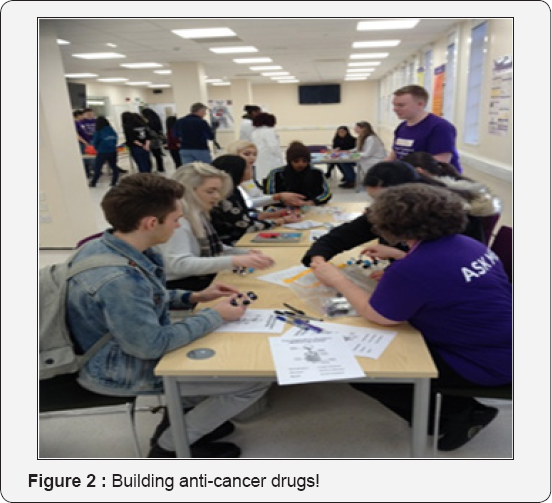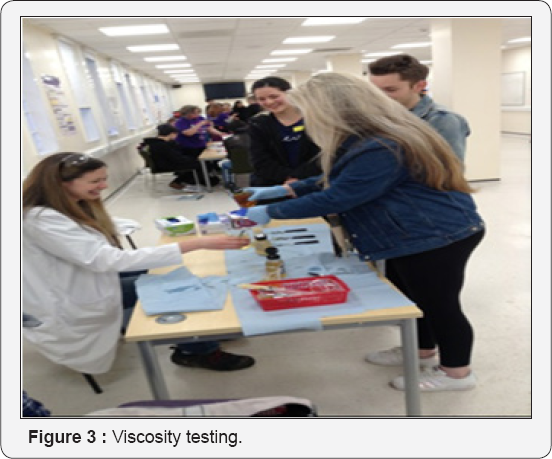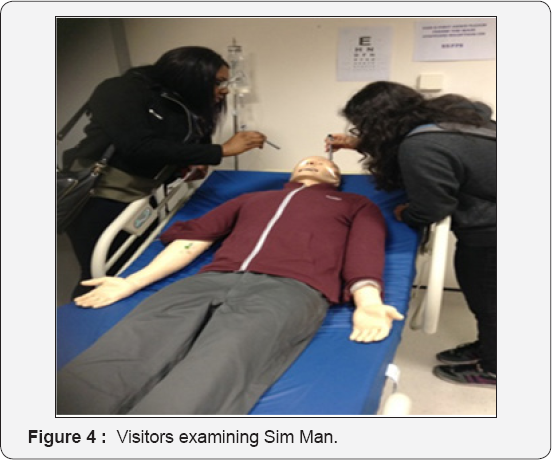From Bench to Bedside: World Cancer Day Open Day Extravaganza
Katherine Finegan and David G Allison*
Division of Pharmacy and Optometry, University of Manchester, UK
Submission: January 25, 2018; Published: March 27, 2018
*Corresponding author: David Allison, Division of Pharmacy and Optometry, School of Health Sciences, University of Manchester, England, UK, Tel: 0161-275-2359; Email: david.allison@manchester.ac.uk
How to cite this article: Katherine F, David G A. From Bench to Bedside: World Cancer Day Open Day Extravaganza. Glob J Pharmaceu Sci. 2018; 5(2): 555657. DOI: 10.19080/GJPPS.2018.05.555657
Opinion
In acknowledgement of it being World Cancer Day, Pharmacy at The University of Manchester hosted a very successful "Introduction to pharmacy teaching" tour around a selection of their pharmacy-specific undergraduate teaching facilities on the 4th February 2017. The aim of the tour was to provide an interactive journey through the drug development process themed around the production of personalized cancer treatments, providing a rare opportunity for external visitors get a flavour of our integrated, research-informed approach to teaching.
Background Teaching Philosophy
Traditionally cancer has been treated as a disease of specific organs. However, recent advances in molecular screening techniques have caused a paradigm shift in the way we view cancer as a disease. We now view and treat cancer as a disease that arises via specific molecular mechanisms, which can span cancer types. By evaluating cancer at the molecular level we can identify the specific mutations that drive a cancer and employ treatments that target those mutations, thus adopting a personalized medicine approach for each patient's cancer. Pharmacy teaching at Manchester very much reflects the recent advent of personalized medicine in cancer therapy. In the first and second year students learn the molecular mechanisms underpinning cancer and then employ this knowledge in years 2, 3 and 4 to understand the mechanisms of action of personalized medicines. Furthermore, we offer a 4th year optional subunit on Cancer Biology for students wishing to explore this subject further.
We also provide practical placements in our cancer research labs for our undergraduate final year projects, based around the molecular characterization of cancers. These placements are highly competitive and provide students with invaluable experience of the practical execution of cancer research. In addition to these science aspects, pharmacy practice elements of cancer screening and medicine guidance and usage are also covered throughout the M.Pharm syllabus, often in collaboration with Cancer charities, along with clinical trials, but for logistical reasons were not included in this particular open day event.
The Activities
Two identical sessions were scheduled, tours taking place 11-1pm and 1-3pm. The majority of the visitors (45 in total) were year 12 students from local colleges that had been selected by their course tutors due to their academic potential but wavering thoughts about higher education as a post-college route. It is well established and a key concern at Manchester Pharmacy that the classroom is not always a welcome environment to learn about science, especially for those who are more disadvantaged from formal learning. It is important therefore to provide opportunities to engage with science outside formal education that are as accessible and engaging for disadvantaged groups as they are for non-disadvantaged families. Hence, the intention at the outset was to raise the profile of science and pharmacy in an exciting, informal manner.
Each intake began with a short (20min) lecture on innovative cancer treatments in a Clinical Skills Suite with a very insightful and energetic question and answer session. The visitors then moved into the Inter-Professional Education Suite where the visual and interactive activities began with a demonstration of differences between cancer and non-cancer cell using decorated polystyrene semi-spheres, accompanied by the opportunity to look down some light microscopes (with laptop imagery) at a variety of real life cancer and non-cancer cells. The initial stages of drug design and modelling were demonstrated through the use of Molymod® kits, visitors being required to assemble molecules of either Gefitinib or Imatinib. Initial targeting of drugs at their active sites was demonstrated using a marble run, assembled in the shape of the human digestive tract with a magnetised marble 'stopping' at select points. Targeting was further emphasised by throwing velcro clad ping pong balls (nanoparticls) at a larger than life poster showing internal organs which had selected pieces of velcro (tumours) attached. Balls that did not stick represented drugs that were eliminated from the body whilst those that did adhere had found their 'target'. As most cancer drugs are made as liquids, ideas behind choosing the right formulation of a drug was demonstrated by visitors examining how the runniness (viscosity) of a drug solution (honey preparations) affects how easy it is to inject, pour and squeeze. Suffice to say the table top was rarer sticky by the end of the day! (Figure 1-4).




Visitors then moved into the next door Project Lab to experience some 3D computational drug design before finishing the tour by considering the interaction of the medicine on either body systems or individual anatomical structures through the use of an anatomage table and a simulated mannequin (Sim Man) in located dedicated studios. The latter can be programmed to show how, for example, cancer drugs affect different systems in the body and will help students to know what to look for when patients are having cancer drugs and the side effects that the drugs may cause. By housing the activities in different teaching areas of Pharmacy, delegates could experience the range of materials and infrastructure used in undergraduate teaching on the MPharm course. Each visitor was also given a pre-prepared booklet summarising each the key drug development stages on show. To help facilitate the event on the day, 24 undergraduate students from across all four years of the MPharm were present who also found the tour to be very informative as it pieced together many different aspects of pharmacy into a coherent whole. Not only did they help chaperone visitors around the various demonstrations but were there to informally chat to the visitors and answer questions about pharmacy and life as a student.
Success or Not?
Visitor feedback was extremely positive, 100% rating the tour as being either excellent or very good. It was also pleasing to see that all of the activities were noted by the visitors when asking to select their 'favourite' science and patient-focussed activity. The 3D drug design, anatomage table and SimMan and were particularly well received. Indeed, some delegates got quite a shock when SimMan spoke! In terms of recommending the tour to friends and colleagues, our event scored an average Likert scale rating of 9.5 out of 10 which speaks volumes. There were no suggestions for improvement, and some free text comments included " ...Just amazing", "It was really interesting and amazing", "I learnt so much and developed my existing knowledge and hope there are more opportunities", "Very eye opening” and perhaps the best quote of all, "Happily spend my Saturdays doing that Seriously considering Pharmacy now. It was brilliant”. These comments really do say it all, Public Engagement / Outreach at its' best!
Final Thoughts
Overall, the Open Day was deemed an overwhelming success, not only in terms of visitors leaving with an enlightened and positive view of both Higher Education and pharmaceutical research, but also in terms of community engagement. By couching our activities in a themed but informal manner, we hope that we will have introduced pharmacy, research and indeed the benefits of Higher Education to a much wider audience than through conventional literature-based approaches. Moreover, events such as this have the potential to raise aspirations by demystifying academia.
Acknowledgement
A massive thank you to all staff, postgraduate and undergraduate students from Pharmacy that helped make this an excellent Open Day Activity.






























